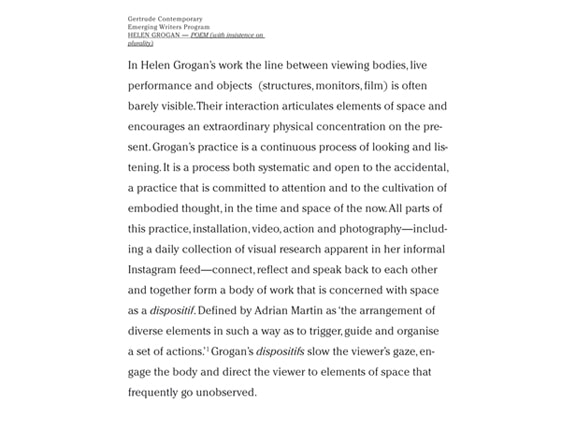programs

EMERGING WRITERS: HELEN GROGAN
Download catalogue here.
In Helen Grogan’s work the line between viewing bodies, live performance and objects (structures, monitors, film) is often barely visible. Their interaction articulates elements of space and encourages an extraordinary physical concentration on the present. Grogan’s practice is a continuous process of looking and listening. It is a process both systematic and open to the accidental, a practice that is committed to attention and to the cultivation of embodied thought, in the time and space of the now. All parts of this practice, installation, video, action and photography—including a daily collection of visual research apparent in her informal Instagram feed—connect, reflect and speak back to each other and together form a body of work that is concerned with space as a dispositif. Defined by Adrian Martin as ‘the arrangement of diverse elements in such a way as to trigger, guide and organise a set of actions.’1 Grogan’s dispositifs slow the viewer’s gaze, engage the body and direct the viewer to elements of space that frequently go unobserved.
This experience of focused attention has, in previous exhibitions, been accompanied by instances of live performance. In THREE ADJOINING SPACES WITH MANIFOLD EDGES (West Space, 2015) the artist enacted two CONCERT works, where structures installed in the gallery—including steel frames, mirrors, monitors and floor matting—were adjusted and reinstalled in front of a dispersed audience. The performance began fluidly out of the time preceding it and, at the start, it was hard to tell who in the room was ‘performing’ and who was ‘watching.’ Grogan’s live works feel, at first, formless and mundane, but then, after a period of time has passed, the work’s structure suddenly breaks open and the body locks into the rhythm of the specific time and space and into a state of what Grogan calls ‘embodied observation.’ Actions that at first appeared disparate and unplanned coalesce with disarming clarity.
In POEM (with insistence on plurality), Grogan removes the performing body from the work, evincing similar effects through the performing object and its interaction with the viewing body. A suspended glass pane directs observation, framing different parts of the room in relation to where the viewer is standing, sitting or walking. This mobile glass frame is cantilevered across the full length of the gallery to a steel trolley structure. The pane and strapping shift in tandem, subject to the conditions of the space. The frame is, as Grogan observes, ‘cast adrift’ and the movement of the pane and position of the viewer in time creates reframings and infinitely variable views. In a sketch video made in preparation for the show, the glass catches the light and the movement of it illuminates the texture of a wall—a material sight that might otherwise go unnoticed. The structure’s action, and the sensation of embodied observation, develops out of the interplay of viewer and moving form.
The effects of Grogan’s work are accumulative. In THREE ADJOINING SPACES WITH MANIFOLD EDGES, Grogan made several films in the gallery during deinstallation that were not seen by the audience or intended to be shown, but nonetheless formed part of the work, both conceptually and as research. Grogan has said that ‘committing to research or a specific experiment often seems more worthwhile than presenting existing, preconceived arguments,’2 and the excessive nature of the video work (it is impossible to watch all the footage) exemplifies this part of her practice. In POEM (with insistence on plurality) video material filmed, edited and reedited in the gallery during the installation and exhibition is displayed on two monitors resting on wheeled structures.The videos are compiled of long takes of the structures installed in the gallery, long takes of the gallery space, long takes of the street outside the gallery, long takes of the work installed in the artist’s studio, and long takes of the work against a backdrop, with photographic studio lighting. The diegetic sounds captured during filming extend the portraits of the space into layered sonic fields, oscillating both between the two monitors, and the interior and exterior of the gallery. The videos draw attention to the formal and material qualities of the structures and to their performances in different spatial contexts, as well as participate in the close observation of the site (both inside and outside).
Through a series of shifts and balances Grogan’s work elicits an experience of being present in this moment, in this space. This is, in part, a result of the harmonisation of two different experiences of duration. At first, the viewer’s experience of duration and that of the work clash, but over time, directed by the dispositif, the two come together, activating attention, embodied observation and the sensation of being in time.
1. Adrian Martin, Mise en scène and Film Style (London: Palgrave Macmillan, 2014), 179.
2. Helen Grogan, ‘Visible Actions, A conversation between Helen Grogan, Eugenia Lim and Elvis Richardson,’ un Magazine, 7.1, accessed 18 December 2015, http://unprojects.org.au/magazine/issues/issue-7-1/visible-actions/